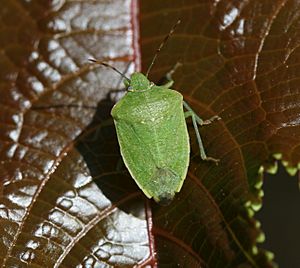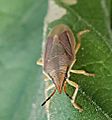Pentatomidae facts for kids
Quick facts for kids Pentatomidae |
|
|---|---|
 |
|
| Nezara viridula | |
| Scientific classification |
|
| Kingdom: | Animalia |
| Phylum: | Arthropoda |
| Class: | Insecta |
| Order: | Hemiptera |
| Suborder: | Heteroptera |
| Infraorder: | Pentatomomorpha |
| Superfamily: | Pentatomoidea |
| Family: | Pentatomidae Leach, 1815 |
| Subfamilies | |
|
|
Pentatomidae is a big family of insects commonly known as stink bugs or shield bugs. Their name comes from Greek words: pente means five, and tomos means section. This refers to their bodies, which often look like they have five distinct parts. There are about 4,700 different kinds, or species, of stink bugs found all over the world!
These insects are known for their unique shield-like shape and, as their name suggests, their ability to release a strong, unpleasant smell when they feel threatened.
Contents
What are Stink Bugs?
Stink bugs belong to a larger group of insects called true bugs. They are easily recognized by their distinctive body shape, which often looks like a small shield. Their bodies are usually broad and flat, and they have a triangle-shaped plate on their back, called a scutellum, that covers part of their wings.
Most stink bugs are plant-eaters, using their straw-like mouthparts to suck juices from plants, fruits, and seeds. However, some species are predators, meaning they hunt and eat other insects.
Why are they called Stink Bugs?
The most famous thing about stink bugs is their smell! When these bugs feel scared or are crushed, they release a stinky liquid from special glands on their bodies. This smell is a defense mechanism, like a warning sign to predators such as birds or lizards, telling them to stay away. The smell can be quite strong and unpleasant, which is how they got their common name.
Where do Stink Bugs Live?
Stink bugs are found in many different parts of the world, from warm tropical areas to cooler regions. They live in various habitats, including:
- Forests
- Gardens
- Farm fields
- Grassy areas
They often hide among leaves or on the stems of plants, where they can easily find food and stay camouflaged.
What do Stink Bugs Eat?
Most stink bugs are herbivores, meaning they eat plants. They use their specialized mouthparts, which are like tiny straws, to pierce plant tissues and suck out the sap or juices. They feed on:
- Leaves
- Stems
- Fruits
- Seeds
Some stink bugs, however, are predators. These helpful bugs hunt and eat other insects, including caterpillars and aphids, which can be pests themselves. This makes predatory stink bugs useful in gardens and farms for natural pest control.
Stink Bugs and Farming
While some stink bugs are helpful predators, many species are considered pests in agriculture. This is because they can cause a lot of damage to important crops. When stink bugs feed on plants, they can:
- Damage fruits, making them look bruised or deformed.
- Cause seeds to shrivel or become discolored.
- Slow down plant growth.
Crops like corn, soybeans, cotton, and various fruits and vegetables can be affected. Farmers often find it challenging to control stink bug populations because these insects can be quite tough and sometimes resistant to pesticides.
Life Cycle of a Stink Bug
Like many insects, stink bugs go through several stages in their life, a process called metamorphosis. Their life cycle usually includes three main stages:
- Egg: Female stink bugs lay their eggs, often in clusters, on the underside of plant leaves. The eggs are usually barrel-shaped and can be different colors.
- Nymph: When the eggs hatch, tiny, wingless young stink bugs called nymphs emerge. Nymphs look like smaller versions of adult stink bugs but don't have fully developed wings. They grow by shedding their outer skin (molting) several times.
- Adult: After several molts, the nymphs become adult stink bugs. Adults have fully developed wings and are ready to reproduce, starting the cycle all over again.
The entire life cycle can take several weeks to a few months, depending on the species and environmental conditions.
Images for kids
See also
 In Spanish: Pentatómidos para niños
In Spanish: Pentatómidos para niños


